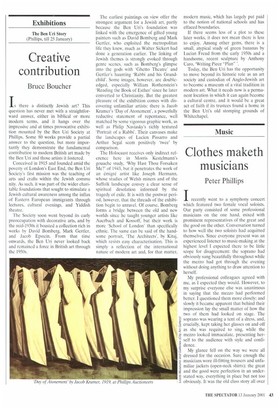Exhibitions
The Ben Uri Story (Phillips, till 25 January)
Creative contribution
Bruce Boucher
Is there a distinctly Jewish art? This question has never met with a straightforward answer, either in biblical or more modern terms, and it hangs over the impressive and at times provocative exhibition mounted by the Ben Uri Society at Phillips. Some 80 works provide a partial answer to the question, but more importantly they demonstrate the fundamental contribution to modern British art made by the Ben Uri and those artists it fostered.
Conceived in 1915 and founded amid the poverty of London's East End, the Ben Uri Society's first mission was the teaching of arts and crafts within the Jewish commu nity. As such, it was part of the wider charitable foundations that sought to stimulate a Jewish cultural awareness among the influx of Eastern European immigrants through lectures, cultural evenings, and Yiddish theatre.
The Society soon went beyond its early preoccupation with decorative arts, and by the mid-1930s it boasted a collection rich in works by David Bomberg, Mark Gertler, and Jacob Epstein. From that time onwards, the Ben Uri never looked back and remained a force in British art through the 1950s. The earliest paintings on view offer the strongest argument for a Jewish art, partly because the Ben Uri's foundation was linked with the emergence of gifted young painters such as David Bomberg and Mark Gentler, who exploited the metropolitan life they knew, much as Walter Sicken had done a generation earlier. The linking of Jewish themes is strongly evoked through genre scenes, such as Bomberg's glimpse into the gods with 'Ghetto Theatre' and Gertler's haunting 'Rabbi and his Grandchild'. Some images, however, are doubleedged, especially William Rothenstein's 'Reading the Book of Esther' since he later converted to Christianity. But the greatest pleasure of the exhibition comes with discovering unfamiliar artists: there is Jacob Kramer's 'Day of Atonement', a powerfully reductive statement of repentance, well matched by some vigorous graphic work, as well as Philip Naviasky's richly textured 'Portrait of a Rabbi'. Their canvases make the landscapes of Lucien Pissarro and Arthur Segal seem positively 'twee' by comparison.
The Holocaust receives only indirect reference here in Morris Kestelmann's gouache study, 'Why Mast Thou Forsaken Me?' of 1943, but it penetrates the work of an émigré artist like Joseph Hermann, whose studies of Welsh miners and of the Suffolk landscape convey a clear sense of spiritual desolation informed by the tragedy of exile. It is with the postwar period, however, that the threads of the exhibition begin to unravel. Of course, Bomberg forms a bridge between the old and new worlds since he taught younger artists like Auerbach and Kossoff, but their work is more 'School of London' than specifically ethnic. The same can be said of the handsome portrait, 'The Architects', by Kitaj, which resists easy characterisation. This is simply a reflection of the international nature of modern art and, for that matter, modern music, which has largely put paid to the notion of national schools and has effaced boundaries.
If there seems less of a plot to these later works, it does not mean there is less to enjoy. Among other gems, there is a small, atypical study of green bananas by Lucian Freud from the early 1950s and a handsome, recent sculpture by Anthony Caro, 'Writing Piece "Plan" '.
Today, the Ben Uri has the opportunity to move beyond its historic role as an art society and custodian of Anglo-Jewish art to become a museum of a vital tradition in modem art. What it needs now is a permanent location in which it can again become a cultural centre, and it would be a great act of faith if its trustees found a home in the Ben Uri's old stomping grounds of Whitechapel.






























































 Previous page
Previous page